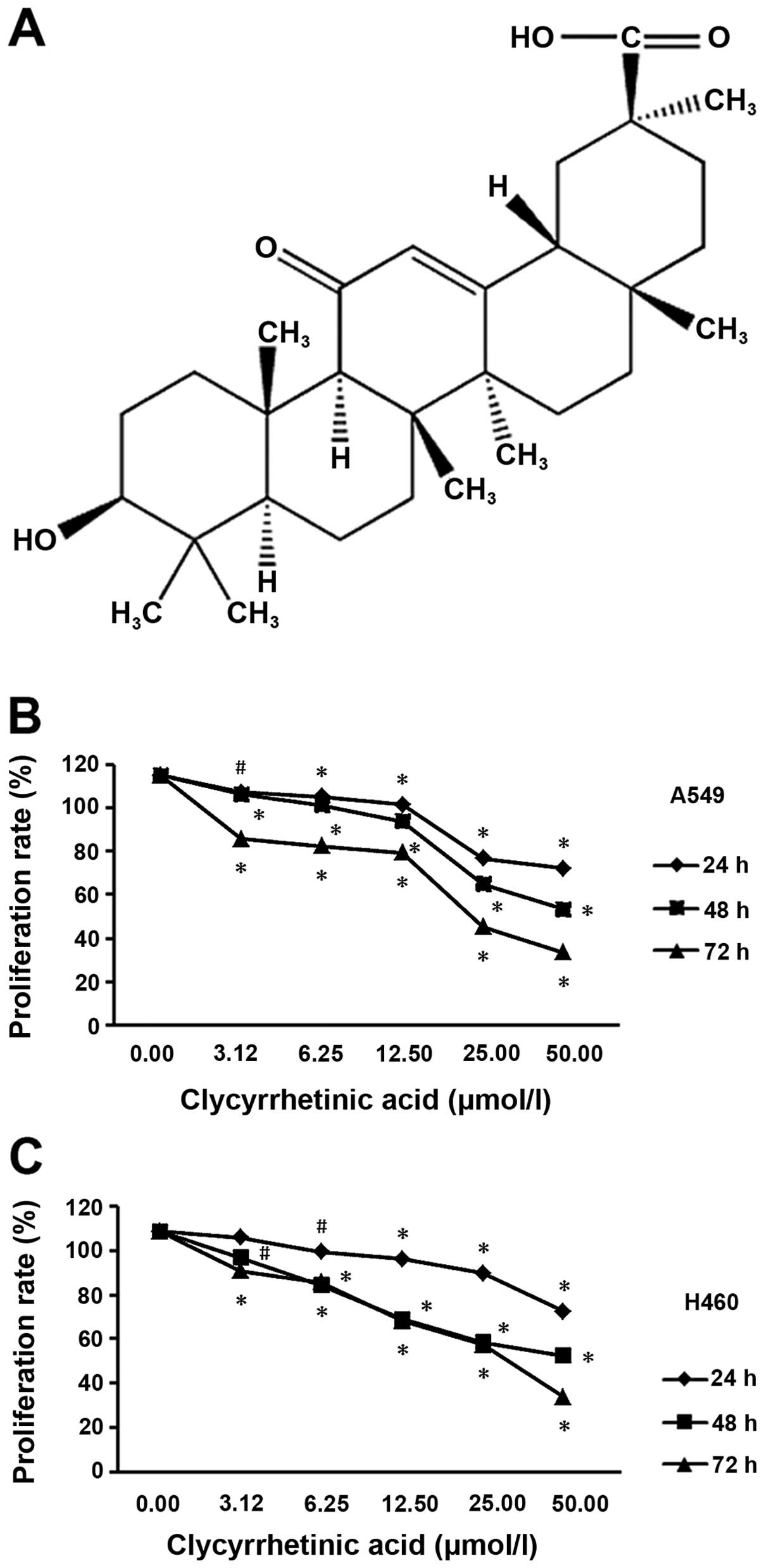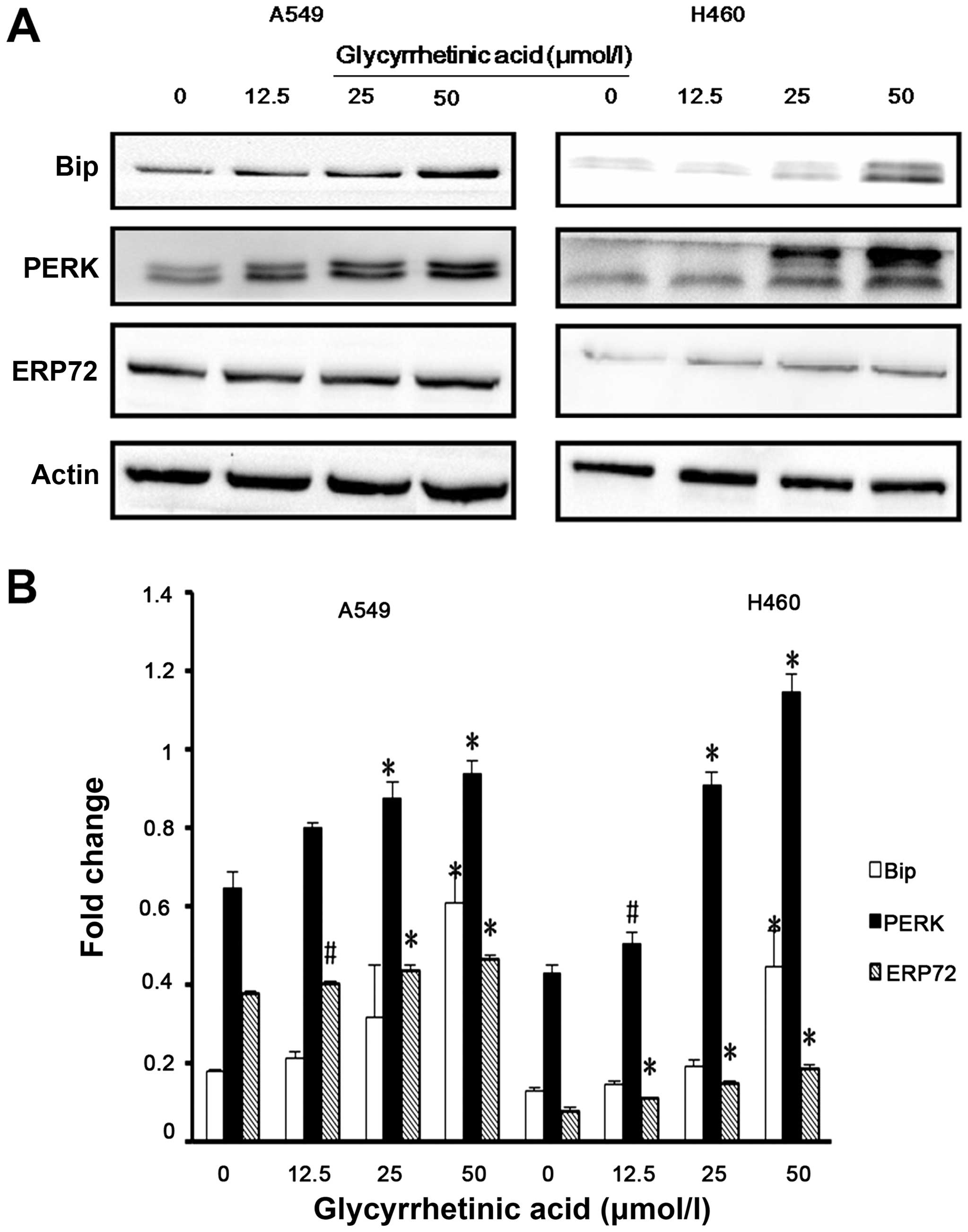|
1
|
Parkin DM, Bray F, Ferlay J and Pisani P:
Global cancer statistics, 2002. CA Cancer J Clin. 55:74–108. 2005.
View Article : Google Scholar : PubMed/NCBI
|
|
2
|
Jemal A, Siegel R, Ward E, Murray T, Xu J
and Thun MJ: Cancer statistics, 2007. CA Cancer J Clin. 57:43–66.
2007. View Article : Google Scholar : PubMed/NCBI
|
|
3
|
Wang T, Nelson RA, Bogardus A and Grannis
FW Jr: Five-year lung cancer survival: which advanced stage
nonsmall cell lung cancer patients attain long-term survival?
Cancer. 116:1518–1525. 2010. View Article : Google Scholar : PubMed/NCBI
|
|
4
|
Carrera S, Buque A, Azkona E, et al:
Epidermal growth factor receptor tyrosine-kinase inhibitor
treatment resistance in non-small cell lung cancer: biological
basis and therapeutic strategies. Clin Transl Oncol. 16:339–350.
2014. View Article : Google Scholar
|
|
5
|
Agarwal MK, Iqbal M and Athar M:
Inhibitory effect of 18beta-glycyrrhetinic acid on
12-O-tetradecanoyl phorbol-13-acetate-induced cutaneous oxidative
stress and tumor promotion in mice. Redox Rep. 10:151–157. 2005.
View Article : Google Scholar : PubMed/NCBI
|
|
6
|
Jeong HG, You HJ, Park SJ, et al:
Hepatoprotective effects of 18beta-glycyrrhetinic acid on carbon
tetrachloride-induced liver injury: inhibition of cytochrome P450
2E1 expression. Pharmacol Res. 46:221–227. 2002. View Article : Google Scholar : PubMed/NCBI
|
|
7
|
Matsui S, Matsumoto H, Sonoda Y, et al:
Glycyrrhizin and related compounds down-regulate production of
inflammatory chemokines IL-8 and eotaxin 1 in a human lung
fibroblast cell line. Int Immunopharmacol. 4:1633–1644. 2004.
View Article : Google Scholar : PubMed/NCBI
|
|
8
|
Abe N, Ebina T and Ishida N: Interferon
induction by glycyrrhizin and glycyrrhetinic acid in mice.
Microbiol Immunol. 26:535–539. 1982. View Article : Google Scholar : PubMed/NCBI
|
|
9
|
Dai JH, Iwatani Y, Ishida T, et al:
Glycyrrhizin enhances interleukin-12 production in peritoneal
macrophages. Immunology. 103:235–243. 2001. View Article : Google Scholar : PubMed/NCBI
|
|
10
|
Ukil A, Biswas A, Das T and Das PK: 18
Beta-glycyrrhetinic acid triggers curative Th1 response and nitric
oxide up-regulation in experimental visceral leishmaniasis
associated with the activation of NF-kappa B. J Immunol.
175:1161–1169. 2005. View Article : Google Scholar : PubMed/NCBI
|
|
11
|
Lee CS, Yang JC, Kim YJ, Jang ER, Kim W
and Myung SC: 18β-glycyrrhetinic acid potentiates apoptotic effect
of trichostatin A on human epithelial ovarian carcinoma cell lines.
Eur J Pharmacol. 649:354–361. 2010. View Article : Google Scholar : PubMed/NCBI
|
|
12
|
Kuang P, Zhao W, Su W, et al:
18β-glycyrrhetinic acid inhibits hepatocellular carcinoma
development by reversing hepatic stellate cell-mediated
immunosuppression in mice. Int J Cancer. 132:1831–1841. 2013.
View Article : Google Scholar
|
|
13
|
Satomi Y, Nishino H and Shibata S:
Glycyrrhetinic acid and related compounds induce G1 arrest and
apoptosis in human hepatocellular carcinoma HepG2. Anticancer Res.
25:4043–4047. 2005.PubMed/NCBI
|
|
14
|
Sharma G, Kar S, Palit S and Das PK:
18β-glycyrrhetinic acid induces apoptosis through modulation of
Akt/FOXO3a/Bim pathway in human breast cancer MCF-7 cells. J Cell
Physiol. 227:1923–1931. 2012. View Article : Google Scholar
|
|
15
|
Wang D, Wong HK, Feng YB and Zhang ZJ:
18Beta-glycyrrhetinic acid induces apoptosis in pituitary adenoma
cells via ROS/MAPKs-mediated pathway. J Neurooncol. 116:221–230.
2014. View Article : Google Scholar
|
|
16
|
Lin KW, Huang AM, Hour TC, Yang SC, Pu YS
and Lin CN: 18β-glycyrrhetinic acid derivatives induced
mitochondrial-mediated apoptosis through reactive oxygen
species-mediated p53 activation in NTUB1 cells. Bioorg Med Chem.
19:4274–4285. 2011. View Article : Google Scholar : PubMed/NCBI
|
|
17
|
Brewer JW, Hendershot LM, Sherr CJ and
Diehl JA: Mammalian unfolded protein response inhibits cyclin D1
translation and cell-cycle progression. Proc Natl Acad Sci USA.
96:8505–8510. 1999. View Article : Google Scholar : PubMed/NCBI
|
|
18
|
Puthalakath H, O’Reilly LA, Gunn P, et al:
ER stress triggers apoptosis by activating BH3-only protein Bim.
Cell. 129:1337–1349. 2007. View Article : Google Scholar : PubMed/NCBI
|
|
19
|
Chu IM, Hengst L and Slingerland JM: The
Cdk inhibitor p27 in human cancer: prognostic potential and
relevance to anticancer therapy. Nat Rev Cancer. 8:253–267. 2008.
View Article : Google Scholar : PubMed/NCBI
|
|
20
|
Pérez-Sayáns M, Suárez-Peñaranda JM,
Gayoso-Diz P, Barros-Angueira F, Gándara-Rey JM and García-García
A: The role of p21Waf1/CIP1 as a Cip/Kip type cell-cycle regulator
in oral squamous cell carcinoma (Review). Med Oral Patol Oral Cir
Bucal. 18:e219–e225. 2013. View Article : Google Scholar : PubMed/NCBI
|
|
21
|
Drexler HG: Review of alterations of the
cyclin-dependent kinase inhibitor INK4 family genes p15, p16, p18
and p19 in human leukemia-lymphoma cells. Leukemia. 12:845–859.
1998. View Article : Google Scholar : PubMed/NCBI
|
|
22
|
Zhu GY, Wong BC, Lu A, et al: Alkylphenols
from the roots of Ardisia brevicaulis induce G1 arrest and
apoptosis through endoplasmic reticulum stress pathway in human
non-small-cell lung cancer cells. Chem Pharm Bull (Tokyo).
60:1029–1036. 2012. View Article : Google Scholar
|
|
23
|
Sherr CJ: Cancer cell cycles. Science.
274:1672–1677. 1996. View Article : Google Scholar : PubMed/NCBI
|
|
24
|
Sherr CJ: D-type cyclins. Trends Biochem
Sci. 20:187–190. 1995. View Article : Google Scholar : PubMed/NCBI
|
|
25
|
Guadagno TM and Newport JW: Cdk2 kinase is
required for entry into mitosis as a positive regulator of
Cdc2-cyclin B kinase activity. Cell. 84:73–82. 1996. View Article : Google Scholar : PubMed/NCBI
|
|
26
|
Geng Y, Whoriskey W, Park MY, et al:
Rescue of cyclin D1 deficiency by knockin cyclin E. Cell.
97:767–777. 1999. View Article : Google Scholar : PubMed/NCBI
|
|
27
|
Jin YH, Choi J, Shin S, Lee KY, Park JH
and Lee SK: Panaxadiol selectively inhibits cyclin A-associated
Cdk2 activity by elevating p21WAF1/CIP1 protein levels in mammalian
cells. Carcinogenesis. 24:1767–1772. 2003. View Article : Google Scholar : PubMed/NCBI
|
|
28
|
Grana X and Reddy EP: Cell cycle control
in mammalian cells: role of cyclins, cyclin dependent kinases
(CDKs), growth suppressor genes and cyclin-dependent kinase
inhibitors (CKIs). Oncogene. 11:211–219. 1995.PubMed/NCBI
|
|
29
|
Bertoli C, Skotheim JM and de Bruin RA:
Control of cell cycle transcription during G1 and S phases. Nat Rev
Mol Cell Biol. 14:518–528. 2013. View
Article : Google Scholar : PubMed/NCBI
|
|
30
|
Harding HP, Zhang Y, Zeng H, et al: An
integrated stress response regulates amino acid metabolism and
resistance to oxidative stress. Mol Cell. 11:619–633. 2003.
View Article : Google Scholar : PubMed/NCBI
|
|
31
|
Shi K, Wang D, Cao X and Ge Y: Endoplasmic
reticulum stress signaling is involved in mitomycin C (MMC)-induced
apoptosis in human fibroblasts via PERK pathway. PLoS One.
8:e593302013. View Article : Google Scholar : PubMed/NCBI
|
|
32
|
Yoon JS, Kim HM, Yadunandam AK, et al:
Neferine isolated from Nelumbo nucifera enhances anti-cancer
activities in Hep3B cells: molecular mechanisms of cell cycle
arrest, ER stress induced apoptosis and anti-angiogenic response.
Phytomedicine. 20:1013–1022. 2013. View Article : Google Scholar : PubMed/NCBI
|
|
33
|
Mazzarella RA, Srinivasan M, Haugejorden
SM and Green M: ERp72, an abundant luminal endoplasmic reticulum
protein, contains three copies of the active site sequences of
protein disulfide isomerase. J Biol Chem. 265:1094–1101.
1990.PubMed/NCBI
|
|
34
|
Brewer JW and Diehl JA: PERK mediates
cell-cycle exit during the mammalian unfolded protein response.
Proc Natl Acad Sci USA. 97:12625–12630. 2000. View Article : Google Scholar : PubMed/NCBI
|
|
35
|
Feng D, Wei J, Gupta S, McGrath BC and
Cavener DR: Acute ablation of PERK results in ER dysfunctions
followed by reduced insulin secretion and cell proliferation. BMC
Cell Biol. 10:612009. View Article : Google Scholar : PubMed/NCBI
|
|
36
|
Han C, Jin L, Mei Y and Wu M: Endoplasmic
reticulum stress inhibits cell cycle progression via induction of
p27 in melanoma cells. Cell Signal. 25:144–149. 2013. View Article : Google Scholar
|
|
37
|
Vitiello PF, Wu YC, Staversky RJ and
O’Reilly MA: p21(Cip1) protects against oxidative stress by
suppressing ER-dependent activation of mitochondrial death
pathways. Free Radic Biol Med. 46:33–41. 2009. View Article : Google Scholar :
|
|
38
|
Hamanaka RB, Bennett BS, Cullinan SB and
Diehl JA: PERK and GCN2 contribute to eIF2alpha phosphorylation and
cell cycle arrest after activation of the unfolded protein response
pathway. Mol Biol Cell. 16:5493–5501. 2005. View Article : Google Scholar : PubMed/NCBI
|















